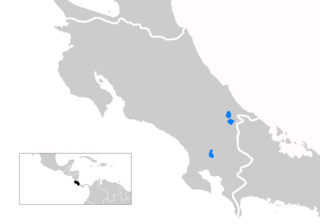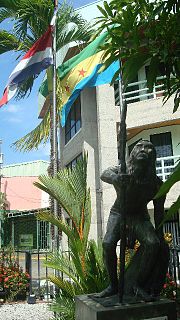Related Research Articles

Costa Rica, officially the Republic of Costa Rica, is a country in Central America, bordered by Nicaragua to the north, the Caribbean Sea to the northeast, Panama to the southeast, the Pacific Ocean to the southwest, and Ecuador to the south of Cocos Island. It has a population of around 5 million in a land area of 51,060 square kilometers. An estimated 333,980 people live in the capital and largest city, San José, with around 2 million people in the surrounding metropolitan area.
The first natives in Costa Rica were hunters, and gatherers, and Costa Rica served as an intermediate region between Mesoamerican and Andean native cultures.

Limón is one of seven provinces in Costa Rica. The province covers an area of 9,189 km², and has a population of 386,862.

The Bribri are an indigenous people of Costa Rica. They live in the Talamanca canton in Limón Province of Costa Rica. They speak the Bribri language and Spanish. There are varying estimates of the population of the tribe. According to a census by the Ministerio de Salud, there are 11,500 Bribri living within service range of the Hone Creek Clinic alone. They are a voting majority in the Puerto Viejo de Talamanca area. Other estimates of tribal population in Costa Rica range much higher, reaching 35,000.

There are several monarchies in Africa, defined as either actually or nominally self-governing states, territories, or nations on the continent of Africa where supreme power resides with an individual who is recognized as the head of state. All are similar in that the sovereign inherits their office and typically keeps it until their death or until their abdication. However, only three are currently sovereign, while the remaining are sub-national monarchies. Two of these are constitutional monarchies, in which the sovereign is bound by laws and customs in the exercise of his or her powers, and one is an absolute monarchy (Eswatini), in which the sovereign rules without bounds. The sub-national monarchies are not sovereign, and exist within larger political associations. In addition to these, there are also three dependencies of two European monarchies.

Spanish conquest of the Chibchan Nations refers to the conquest by the Spanish monarchy of the Chibcha language-speaking nations, mainly the Muisca and Tairona that inhabited present-day Colombia, beginning the Spanish colonization of the Americas.
The pre-Columbian history of Costa Rica extends from the establishment of the first settlers until the arrival of Christopher Columbus to the Americas.

This is an Index of Central America-related articles. This index defines Central America as the seven nations of Belize, Costa Rica, El Salvador, Guatemala, Honduras, Nicaragua, and Panama.
The Western Caribbean Zone is a region consisting of the Caribbean coasts of Central America, from Yucatán in Mexico to northern Colombia, and also the islands west of Jamaica. The zone emerged in the late sixteenth century as the Spanish failed to completely conquer many sections of the coast, and northern European powers supported opposition to Spain, sometimes through alliances with local powers.

Indigenous people of Costa Rica, or Native Costa Ricans, are the people who lived in what is now Costa Rica prior to European and African contact and the descendants of those peoples. About 114,000 indigenous people live in the country, comprising 2.4% of the total population. Indigenous Costa Ricans strive to keep their cultural traditions and language alive.
The Kingdom of Talamanca was a political entity existing during the historic period covered between the Executive Decree issued by the Costa Rican government on July 25, 1867, recognizing the Talamanca indigenous monarchs as "political chiefs" of the region, until the death of their last king Antonio Saldaña in 1910, apparently poisoned, and who died without heirs thus putting an end to the line of succession.
Santiago Mayas was a native King of Talamanca, Costa Rica, born around 1834. He belonged to the ethnic group of the Bribris, of which he was crowned in 1862, although subject to the authority of King Chirimo, which he succeeded around 1870. In his youth he befriended many foreign visitors, and as king appointed as his secretary the American marine John H. Lyon, who married one of his relatives.
Birche was an indigenous king of Costa Rica at the end of the 19th century, pertaining to the Bribri ethnic group. He was a relative of King Santiago Mayas, in whose murder he participated in January 1872, due to his links with the rebel leader Lapis. He was proclaimed successor of Mayas and went to Limón to meet with the Costa Rican governor of the region, who granted him the governmental recognition, despite his participation in the regicide. As second leader was recognized another relative of his, William Forbes, nicknamed King Willie.
Antonio Saldaña was a Bribri cacique and the last king of Talamanca in Costa Rica.

The Cacicazgo de Talamanca was a Costa Rican indigenous manor that existed prior to the Spanish conquest and during the colony. It had borders on the north with the kingdom of Tariaca, on the west with Chirripó and on the southeast with the river Changuinola, natural border with the Terbis. Within the kingdom coexisted two indigenous groups, the Bribris and the Cabécares.
Pablo Presbere was an indigenous king of the community of Suinse, in the region that is now known as Talamanca, in the south-east of Costa Rica. He is remembered as the indigenous leader who led the aboriginal insurrection in "Tierra Adentro" against the Spanish authorities on September 29, 1709, in the course of which several friars and soldiers and the wife of one of these were killed and fourteen temples erected by the missionaries were set ablaze. The rebellion was supported by all the natives of Costa Rica from Cerro Chirripó to Isla Tojar, in Almirante Bay, Panama, with the exception of the Viceitas, and allowed the aboriginals to regain control of the territory of Talamanca, which became in a refuge area during the colonial period of Costa Rica. He was known as "the most feared warrior in Talamanca. Some sources argue that his original indian name "Pabru" means "chief of the macaw" and "Preberi" would be "Place of running waters". The macaw is a bird of religious significance for the Bribri people thus, some scholars argue that Presbere was actually a shaman or religious leader and not from a warrior caste, which may also explain both the respect that he inspired in other natives and the fear that the Spaniards had for him.

The Bribri Talamanca Indigenous Territory is one of the four Costa Rican indigenous territories of the Bribri ethnic group. It borders the Talamanca Cabecar Indigenous Territory. It was created by decree in 1985 and is located in the canton of Talamanca, Limón Province. It covers an approximate area of 43,690 hectares of a predominantly mountainous area.
Ramón Almengor a.k.a. Siarke was the last king of the indigenous Bribris. Son of María Saldaña and Floripo Almengor, he was the nephew of Antonio Saldaña, the last king of Talamanca who died in 1910. While Saldaña enjoyed the recognition of Bribris, Cabécares, Changuinolas and Borucas and of the recognition of the government of Costa Rica, Siarke was only recognized by the Bribris. He died of tuberculosis at the San Juan de Dios Hospital on January 28, 1922.

Garabito was an indigenous king of the Huetar ethnic group, who approximately between 1561 and 1574 was a monarch of the Western Huetar Kingdom and its surroundings, in the current territory of Costa Rica. A 1566 document indicates that in 1561 he succeeded his grandfather, although given that in the indigenous kingdoms of the Intermediate Area of Costa Rica, matrilineal succession prevailed, it is more likely that his predecessor was a maternal uncle.
Correque was an indigenous monarch of Costa Rica, king of the Eastern Huetares, who lived in the 16th century. He had several residences and resisted the Conquistadors for some time until he moved one of his courts from Ujarrás to Tucurrique to escape them. He was preceded by El Guarco and succeeded by Alonso Correque.
References
- 1 2 3 Muñoz, Eduardo (2009). "Investigación revela detalles del último cacique". Semanario Universidad. Retrieved 23 December 2018.
- 1 2 3 González Vásquez, Fernando (2010). "Un rey nacido en Costa Rica". La Nación. Retrieved 23 December 2018.